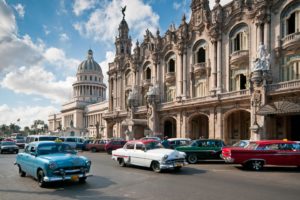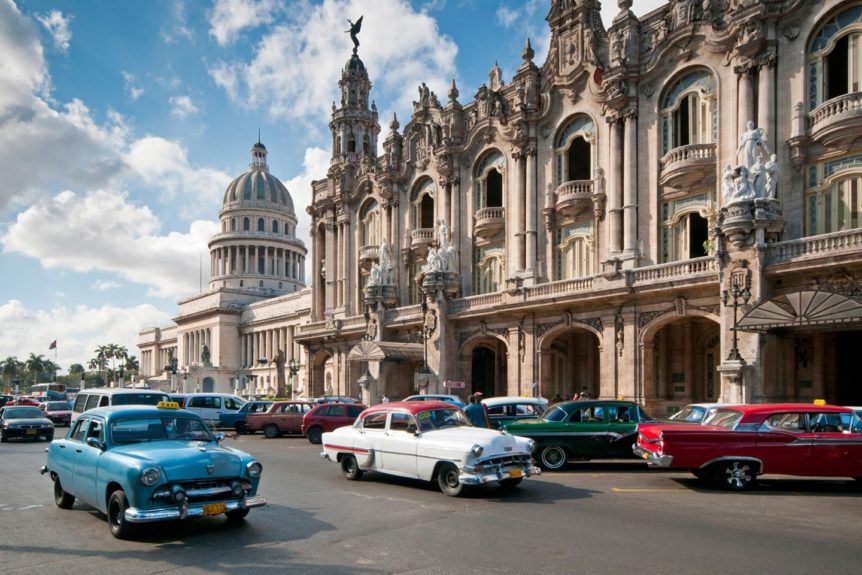Since President Obama lifted a few travel restrictions to Cuba in December 2014,Americans have been scrambling to figure out how to get down to the elusive island. But despite the progress made towards establishing full diplomatic relations again, there’s still quite a bit of confusion around how an ordinary US citizen can travel there without going through Canada first. Havana private tour is the ultimate adventure that let you explore the real life in the country’s capital.
Begin in the city’s colonial heart: Habana Vieja. Founded in 1519, Old Havana was built around the natural port of Havana Bay. Wandering with your guide through its narrow streets you can soak up the colonial atmosphere while visiting such grand buildings as the Catedral de San Cristóbal, La Cabaña Fort and Castillo del Morro. Learn about everything from Cuba’s pre-Columbian culture to the present-day socialist regime at the Museo de la Revolución. When you’re ready for a drink, in the Havana private tour your guide can recommend the best place for a refreshing Mojito – perhaps at one of the bars Hemingway used to frequent.
UNESCO World Heritage Site, Old Havana, Cuba

Founded in 1519 under the name of Villa de San Cristóbal de La Habana, Old Havana is the historical center of the Cuban capital of Havana. At the time, travel between the Old World and the New World by sea meant that Spanish Galleons would be passing by the island of Cuba, and Havana quickly became one of the biggest shipbuilding centers of the time period.
Much of Havana Vieja was constructed during the Spanish colonial time period which is apparent in the city’s baroque and neoclassic architecture. Old Havana is listed as a UNESCO World Heritage Site, and many of the buildings that fell into ruin after the colonial period are now being restored to their former status and appearance.
The city was burned to the ground by the French pirate Jacques de Sores after he captured the city in its earliest days, and it was after this incident that the Spanish built the city walls and fortresses that can still be seen in the area today.
Castillo de la Real Fuerza, the city’s first fortress, was constructed in 1558; Castillo del Morro, built in 1587, San Salvador de la Punta among others are all architecturally magnificent and best examples of Cuba’s military architecture, and each has a unique history that is not to be missed.
There are many incredible attractions and historic things to do and see in Old Havana. An excellent way to explore Old Havana, is to embark on one Havana private tour of the guided vintage cars tours that follows the narrow cobblestone streets that connect the main colonial squares. Not to miss:
Havana private tour
The Square of Arms, the oldest square in Old Havana and the original place of the foundation of the city, was named after the military exercises, events and ceremonies that used to take place in the square in the sixteen century. Today is Old Havana’s main tourist square, and it is surrounded by the most important colonial buildings such as the Palace of the Captain Generals, the Palacio del Segundo Cabo, the Fortress of the Royal Force, El Templete, and others.
Plaza de San Francisco was the harbour front of the city in colonial times. Galleons full of Spanish emigrants and African slaves used to unload and stock up in this waterfront square before continuing on journey to Las Americas or returning to Spain. Soon it became the main trade hub of the city where all sorts of goods and merchandise were exchanged. In 1909 a formal Goods Exchange was established when Lonja del Comercio neo-classical building was completed.
Another buildings of great significance surrounding the square are Terminal Marítima Sierra Maestra, the Palace of The Marquis of San Felipe y Santiago de Bejucal, the Havana Customs building, among others. Worth mentioning the Fuente de Los Leones, a white Carrara marble fountain and sculptural ensemble at the heart of the square dating from 1836.
Plaza Vieja, or the Old Square, is perhaps the most eclectic of all squares as it is surrounded by beautiful mansions and colonial buildings from the XVII, XVIII and XIX and even some examples of the early twentieth century. It is the only colonial square in the historical center that is not loomed over by a former Spanish government building or a church. Its uses vary from executions to religious processions to bullfights under Spanish ruling.
Plaza del Cristo, or Cristo Square, takes its name from the Church of the Holy Christ of the Good Voyage that presides over the square. Sailors used to visit the church before embarking on a passage to Spain or Las Americas, or upon return to ask for good fortunes during the journey or give thanks for a safe return.
Plaza de La Catedral, or The Cathedral Square, is the most beautiful intimate colonial square built in colonial Havana. Yet in the 16th Century it was known as the “swamp square” because rainwater and sea water used to accumulate in this area as it was the lowest area in the city and so close to the sea.
Areas in Havana
Havana is divided into 15 municipalities, each with its own neighborhoods and distinctive feel. For travelers, the city is divided into several larger areas. The Habana Vieja area, also known as Old Havana is the heart of the city’s colonial history and was declared an UNESCO World Heritage Site in 1982. Centro Habana, or Central Havana, is a mainly residential area where tourists seldom visit, because of the building decay and decomposition. Vedado is an upper-middle class area and full of hotels, tourist attractions and restaurants as well as the Plaza de la Revolucion, the location of governmental agencies, the national library and the national theater. The Playa area, including Miramar, is an upscale area, where diplomats and foreign residents often live and is home to several upscale hotels and resorts, as well as Cuba’s national aquarium. Located across Havana Harbor are the city’s beaches, located in Playas del Este, while the nearby Habana del Este is home to several working-class neighborhoods.
Tourist Tips
Havana private tour is safe city for tourists, as the police presence is strong throughout the city and crime is fairly uncommon. However, many areas are poorly lit at night and visitors should avoid wearing expensive jewelry or carrying large amounts of money, because of the economic disparity between tourists and city residents. While the months of November through May are considered the city’s busy season for the Havana private tour, with higher hotel rates, more moderate temperatures and larger crowds, the hurricane season, from June to October sees less crowds and lower rates.

